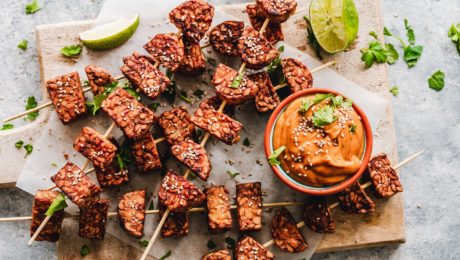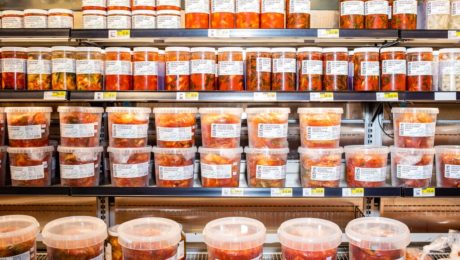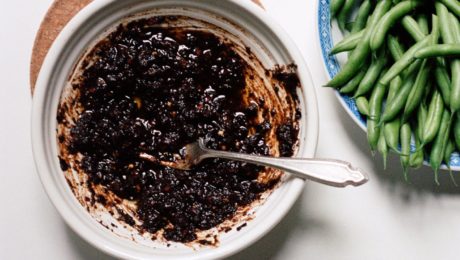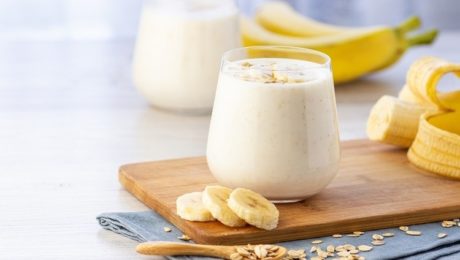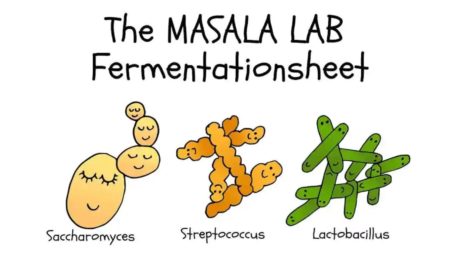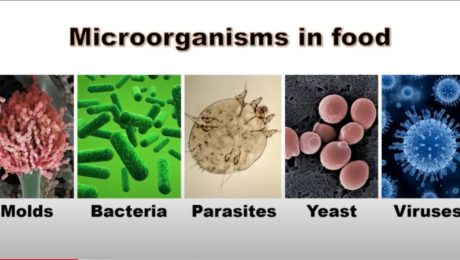TFA Fermentation News Goes Mainstream
Three weeks ago, The Fermentation Association shared results of a Stanford study that found fermented foods improve health. Numerous media outlets picked up on the study results, too, and now The New York Times has shared them as well, reporting: “Now scientists are discovering that fermented foods may have intriguing effects on our gut. Eating these foods may alter the makeup of the trillions of bacteria, viruses and fungi that inhabit our intestinal tracts, collectively known as the gut microbiome. They may also lead to lower levels of body-wide inflammation, which scientists increasingly link to a range of diseases tied to aging.”
The Times article pointed out that the study results challenge the long-held belief that fiber-rich foods are good for the gut. A high-fiber diet instead showed little impact on the makeup of the gut microbiome. In fact, study participants who “had the least microbial diversity had slight increases in inflammation when they ate more fiber…” suggesting they lacked the microbes to digest the amount of fiber consumed.
Meanwhile, the participants that consumed a diet high in fermented foods had a greater number of microbial species develop in their gut. And only 5% of those new microbes were directly from the fermented foods they ate. “The vast majority came from somewhere else, and we don’t know where,” says Justin Sonnenburg, an author of the new study and a professor of microbiology and immunology at Stanford.
Read more (The New York Times)
Surströmming – the Next International Craze?
A new Forbes article highlights surströmming, the fermented Baltic herring that’s a delicacy in Sweden. Considered one of the smelliest foods in the world, surströmming has become the darling of Sweden’s Disgusting Food Museum. The New Yorker recently published a piece on the museum, titled “The Gatekeepers Who Get to Decide What Food is Disgusting.” Manufacturer The Swedish Surströmming Supplier is promoting a surströmming challenge, encouraging people to post videos of themselves eating the fermented fish. The company says, once people “get past the initial shock of how it looks and smells when taken from the can,” many enjoy it. Surströmming is typically eaten with flatbread, potatoes, sour cream, chives and dill. (Forbes)
Read more (Forbes)
- Published in Food & Flavor
Ancient Fermented Beans
The traditional Chinese recipe of fermented black soybeans known as dou si has made the pages of Saveur. Hetty McKinnon, a Chinese Australian cook and author, shares her mother’s penchant for flavoring dishes with these aromatic beans. Dou si is used in salad dressings and dishes like noodles, stews and stir-fries.
McKinnon writes: “Made from black soybeans that have been inoculated with mold, dou si is then salted and left to dry. Time — six months or so — imparts a robust, multi-dimensional flavor, reminiscent of other aged foods like parmesan cheese and olives. In my kitchen, the ingredient is a weeknight workhorse, and a quick way to add nuance and complexity to a meal with minimal effort and ingredients.”
Read more (Saveur)
- Published in Food & Flavor
Defining Postbiotics
As postbiotics continue to trend among consumers, the International Scientific Association for Probiotics and Prebiotics (ISAPP) released a consensus definition on the category, published in Nature Reviews: Gastroenterology & Hepatology.
The panel of international experts that created the definition made it clear that postbiotics and probiotics are fundamentally different. Probiotics are live microorganisms; postbiotics are non-living microorganisms. The published definition states that postbiotics are a: “preparation of inanimate microorganisms and/or their components that confers a health benefit on the host.”
Inactive Microorganisms
A postbiotic could be whole microbial cells or components of cells, “as long as they have somehow been deliberately inactivated,” according to the news release by ISAPP. And a postbiotic does not need to be derived from a probiotic.
“With this definition of postbiotics, we wanted to acknowledge that different live microorganisms respond to different methods of inactivation,” says Seppo Salminen, professor at the University of Turku and the lead author of the definition. “Furthermore, we used the word ‘inanimate’ in favor of words such as ‘killed’ or ‘inert’ because the latter could suggest the products had no biological activity.”
The definition has been in the works for almost two years by authors from various disciplines in the probiotics and postbiotics fields. These include: gastroenterology, pediatrics, metabolomics, functional genomics, cellular physiology and immunology.
“This was a challenging definition to settle,” says Mary Ellen Sanders, ISAPP’s Executive Science Officer. “There are some who think that any purified component from microbial growth should be considered to be a postbiotic, but the panel clearly felt that purified, microbe-derived substances, for example, butyrate or any antibiotic, should just be called by their chemical names. We are confident we captured the essential elements of the postbiotic concept, allowing for many innovative products in this category in the years ahead.”
Growing Scientific Interest
Sanders continues: “The definition will be a touchstone for scientists, both in academia and industry, as they work to develop products that benefit host health in new ways. We hope this clarified definition will be embraced by all stakeholders, so that when the term ‘postbiotics’ is used on a product, consumers will know what to expect.”
Postbiotics have been on the market in Japan for years, and fermented infant formulas with added postbiotics are sold commercially in South America, the Middle East and in some European countries. ISAPP, in a release, notes: “Given the scientific groundswell, postbiotic applications are likely to expand quickly.”
The definition is the latest in a series of international consensus definitions by ISAPP. These include: probiotics, prebiotics, synbiotics and fermented foods.
- Probiotics: Live microorganisms that, when administered in adequate amounts, confer a health benefit on the host.
- Prebiotics: A substrate that is selectively utilized by host microorganisms conferring a health benefit.
- Synbiotics: A mixture comprising live microorganisms and substrate(s) selectively utilized by host microorganisms that confers a health benefit on the host.
- Fermented foods: Foods made through desired microbial growth and enzymatic conversions of food components.
- Published in Science
Dairy-Free “Vegurt”
Chr. Hansen, a global bioscience supplier of ingredients, has developed Vega Culture Kits, a new line of probiotic starter cultures that can be used to create plant-based yogurt. “Vegurt,” a shortening of vegan or vegetarian yogurt, is the name being used for this non-dairy product. This term was created in reaction to the European Parliament’s current debate over whether plant-based products can use dairy-related terms like yogurt and milk.
“Vegurt seemed a catchy and suitable category name compared to having to sprain our tongues calling them ‘fermented plant-based alternatives to dairy yogurt,’” said Dr. Ross Critenden, senior director for commercial development at Chr. Hansen.
The Vega Culture Kits are designed to “robustly ferment” any dairy-free plant base, like nuts, cereals, legumes or seeds. The Vega Culture will appear as “culture” on ingredient lists, in the same way that dairy yogurts include “culture” when cultures or probiotic strains are added.
Read more (Food Navigator)
- Published in Science
“Strategic Rotting”
Fermentation saved the human diet, argues Krish Ashok, author of Masala Lab: The Science of Indian Cooking. He calls fermentation strategic rotting. The discovery of fire was key to the human’s survival as they learned to cook meat, but fermentation allowed civilization to create bread and alcohol, turn milk into yogurt and preserve a harvest through the winter.
“Fast forward a few millennia, and we have mastered fermentation to the point where we can pick and choose microbes with precision and generate complex flavours in the bargain,” Ashok writes. Pictured, his charming drawings illustrate microbes used in fermentation.
Read more (Mint Lounge)
- Published in Food & Flavor
Fish Sauce Without the Fish
Vegan chefs are creating animal-free fish sauce, using ingredients like seaweed, mushrooms, pineapple, soybeans, black beans and tofu for “the obvious oomph of umami.” A recent piece on Vice.com reported that many of these chefs were reluctant to use anything other than traditional fish-based ingredients. But they’ve found that these new fish sauces are especially popular with younger customers, many of whom are vegan or reducing the amount of meat-based products in their diets.
“Across the animal-free spectrum, home cooks and chefs have gotten creative as they deconstruct and recreate the magic of fermented fish,” continues the article.
Raj Abat, chef at New York’s plant-based Filipino restaurant Saramsan, was initially skeptical that a vegan fish sauce could work, but he found that fermentation was the transformative element. He said: “My first thought was: It has to look dark and black, and it has to smell really, really bad. Fermentation does that. It makes everything smell really funky, but when you taste it, it’s so delicious.”
Read more (Vice)
- Published in Food & Flavor
The Safety of Fermented Food
Thanks to lactic acid — which kills harmful bacteria during fermentation — fermented foods are arguably among the safest foods that humans eat. But if critical errors are made, there is the risk of food safety hazards.
“When we talk about fruit and vegetable ferments, there is a very long history of microbial safety with traditionally fermented fruits and vegetables,” says Erin DiCaprio, extension specialist at University of California, Davis, Department of Food Science and Technology. “While outbreaks associated with fermented fruits and vegetables are rare, vegetable and fruit fermentation is not without risk.”
DiCaprio, a food safety expert, detailed proper food safety protocols during a webinar for EATLAC, a UC Davis project putting scientific knowledge and research behind fermentation. DiCaprio shared two documented instances of fermented foods causing a foodborne illness, both from small-scale batches of kimchi. But she emphasized that, when all food safety concerns are mitigated, fermented foods do not pose a risk.
“From the food microbiology standpoint, bacteria really are the most important group of microorganisms because bacteria, certain types of bacteria, are a food safety concern,” she adds. “There are many different types of bacteria that contribute to food spoilage and, of course, there are specific types of bacteria that are used beneficially for fermentation.”
What happens during fermentation that makes food safe? Lactic acid bacteria are created, which convert sugars into lactic acid, acetic acid and CO2. Those antimicrobial compounds help fight off pathogens, competing with other microbes for nutrition sources.
Biological hazards — bacteria, viruses and parasites that can cause foodborne illnesses — are the biggest concerns. Botulism, E. coli and salmonella are the main hazards for fermented foods. Botulism can form in oxygen-free conditions if a fermentation is not successful and acid levels are too low. E. coli and salmonella form when sanitation practices are not followed.
“Commercially, when someone is developing a valid fermentation process, they are typically going to be looking to see that sufficient acid is produced during fermentation, to inactivate some of these acid tolerant (bacteria),” DiCaprio says. “Our traditional vegetable fermentations — things like fermented cucumber, sauerkraut, kimchi — they’ve all been shown to produce sufficient acid to inactivate the sugar toxin producing e-coli, so from a safety standpoint, sufficient acid production is the critical control point for ensuring the safety of a fermented fruit or vegetable. “
There are seven critical factors to keep a ferment safe:
- High-quality, raw ingredients. “If there are a high number of spoilage microorganisms to start with, it will be really difficult for the lactic acid bacteria to dominate the fermentation,” DiCaprio says.
- Research-based recipe. Following a tested recipe ensures the proper balance of ingredients to keep the food safe.
- Proper sanitation. Cleaning of all utensils and surfaces ensures no pathogens will contaminate the food. This mitigates cross-contamination risk, too.
- Preparation of ingredients. Food particles should be uniform in size, either cut in small slices or shredded. Smaller pieces release more water and nutrients, promoting the growth of lactic acid bacteria.
- Salt concentration. Lactic acid bacteria thrive in a salt brine. The key amount: anywhere from 1-15% salt brine by weight of the ferment.
- Appropriate temperature. A temperature between 65-75 degrees fahrenheit is ideal to keep spoilage microorganisms at bay.
- Adequate time. “It takes a while for significant acid to be produced, so be patient and follow the directions in the recipe,” DiCaprio advises. Most fruit and vegetable ferments take 3-6 weeks to be completed.
Q&A: Sophie Burov, Secret Lands Farm
When Sophie and Alexander Burov moved to Toronto, Canada, from Moscow, Russia, in 2007, farming wasn’t on their radar. Both entrepreneurs — she in fashion, he in mining — they were accustomed to life in one of the biggest cities in the world, not to rural farming. And their knowledge of fermented dairy was limited to taste — Alexander loved the tangy kefir he’d been drinking since childhood; Sophie devoured cheese and yogurt.
Sophie was a sheep’s milk aficionado, having tried it years earlier, She had fallen in love with its flavor, but soon learned how hard it was to find fresh sheep’s milk, especially in her native Russia. So when she met a producer at a farmer’s market in Canada, Sophie felt inspired to make her own sheep’s milk products.
“At that moment, I couldn’t even imagine running a farm,” Sophie says. She volunteered at a local dairy and sheep farm, quickly learning that: “Business is business and farming is business too, but it’s love as well. Farming is a lot of love.”
Today, Sophie, Alexander and their son Roman run the 150-acre Secret Lands Farms, south of Owen Sound in Ontario, Canada. Utilizing old-world European farming traditions, they produce a range of artisanal sheep’s milk dairy products at their on-site creamery: kefir, two varieties of yogurt, and 25 cheeses. Their kefir — made from centuries-old Tibetian grains — is also the base for their cheeses. Secret Lands is the only producer in Canada (and one of few in North America) using kefir grains as a culture for cheese.
“Seeing is believing — but tasting is falling in love,” Sophie says. “When you taste our product, you can feel the love.”
Sophie recently spoke with TFA; below are highlights from the interview.
The Fermentation Association: You purchased the farm seven years ago. Farming is hard work! Tell me what made you decide to purchase a farm?
Sophie Burov: Yes, we purchased it in 2013. The idea came about eight years ago. You know sometimes when you reach a point when you need to reconsider the purpose of your life and what you’re doing, why you’re doing it, what’s the purpose of your existing?
The agricultural sector is huge in Canada but not dairy sheep farming , so I started thinking about it as a hobby farm and we’d still live in the city, but it turned in a different direction because if you want just a hobby, it will only be your hobby. If you want something serious, your life and dedication is different when it’s your life. I believe it’s from guidance from God, I was praying a lot.
Looking back, this is the hardest job me and my husband have ever done. But it’s rewarding mentally. I believe in the spirit of the land and the animals and what you’re doing through the product you give to people, you become a bridge connection between the land and the people. Through the product, you can tell much more than through words.
If you want to go farming for money and there’s no love between you and the animals, forget it. There has to be love between you and the animals. Everyday they are teaching us how to be better human beings because sheep are very social. They are also very appreciative animals. They give back their love. If they’re struggling, you’re struggling with them.
We were very, very lucky, because we found the first sheep dairy farmers and breeders in North America — Axel Meister and his wife, Chris Buschbeck [owner of WoolDrift Farm in Markdale, Grey County, Ontario]. They brought this flock from Germany in the middle of the ‘80s and they started developing this flock in the middle of North America. When we decided to do this farm, we met Axel and started going to his farm and volunteering and he was guiding us, telling us what books to read and what to pay attention to with the sheep. His wife Chris is a vet for sheep and she helps us with our sheep.
TFA: How long did it take you to become experts at sheep farming?
SB: We are still learning. The first three years were extremely, extremely difficult. It was a hard time because, working as a volunteer at these different farms, it was very different compared to doing it yourself because all the ups, they’re yours, and all the downs, they’re yours.
TFA: Where do you sell your products?
SB: We sell at the farmers market on Saturday and home delivery twice a week. I believe home delivery is another bridge between the customers and us. If they have questions, we’re always here to answer. It’s not the easiest way to do it, but I believe that for small farmers and small producers, it’s the best way to connect with your customers and make money. We tried to work with retail stores, but retail chains, they are squeezing you. There’s no money for small farms. You can increase your flock, your production, to make more money, but we do not wish to become huge. For now it’s an ideal model for us to sell through online sales to all of the Canadanian provinces
TFA: What is a typical day like at the farm?
SB: Everyday is different. From the beginning, we were working like slaves. It was very unhealthy, all of us were sleeping just an hour, working at the farm then driving to the farmers market. Sometimes our working time was 22 hours a day, it was killing us. But now it’s easier because we have people who can help us in production and my husband Alex has people helping him on the farm, so it’s a little easier. [Secret Lands has anywhere from 8-10 employees, depending on the season].
The most difficult period of the year is lambing season. My husband and son are not sleeping at all. They have naps, but then they’re back to the barn. We do lambing once a year for a few months in spring. We do not do artificial insemination, we do it the way nature intended. The sheep are pasture-raised, grass-fed and no hormones.
TFA: You are Russian natives, where kefir originates from. Did you have kefir before starting the farm?
SB: Yes, kefir started in Russia, it began end of the 19th Century. It came from the Caucasus Mountains. But to be honest, when I started thinking about farming and a sheep dairy farm, I didnt even think about kefir, I was thinking about just yogurt because at that moment I was a yogurt and cheese person. I have hated kefir since I was a kid. My husband has been loving it since he was born.
But when we met our sheep breeder, at that moment he gave me a glass of kefir at his farm. He was just producing kefir for himself, I tried it and thought this was interesting. He gave me a handful of kefir grains, and I made kefir and brought it to our church community for people to try and share with people our idea of what we would be doing on the farm. One lady started asking me so many questions about kefir. And I realized my knowledge about kefir is null. I went back home and started my research and I was just shocked. It was so amazing, it was my ah-ha moment. Kefir is incomparable with yogurt in nutrition. Then my amazement was doubled, tripled, because sheep’s milk kefir, the product is different, the amount of calcium is much higher than cow’s or goat’s milk. In the kefir variation, our body will assimilate twice the calcium and protein.
The real kefir — made from kefir grains — it’s very limited on the market because it’s difficult to make. Seven years ago I had a handful of kefir grains, but now I can produce nine pails of 15 liters each of kefir at the same time. It’s not a huge amount actually if we compare it to someone who does it commercially. It’s impossible to make money with that amount of product. When people ask why our product is high priced, I tell them because it’s the real stuff.
TFA: Tell me some of the benefits of sheep’s milk kefir.
SB: It’s a natural probiotic, it’s the most natural probiotic in the whole world. Some scientists are saying it has 50 different variations of probiotics.
If you are taking pills or taking kefir from commercial cultures, you are not digesting the good bacteria. But if you take the real kefir, it’s becoming you and it works. People ask “Why am I supposed to drink it all the time? What’s the reason?” I tell them even the best troops in the whole world can do a lot, but if you are not feeding them, they become weak. These troops are fighting the bacteria in your body and they’re fighting nonstop, invisibly fighting bad bacteria in your body. People need to understand there’s no miracle. You can’t drink a glass or a liter and that’s all. You need to do it constantly and it will give you the health benefits from the nutrients and vitamins. I drink half a glass for my breakfast and and half a glass at night.
In kefir, your body assimilates the nutrients and vitamins. Sheep’s milk is easier to digest because it’s closest to mother’s milk, more than goat or cow milk — it’s a superior milk. You can even freeze this milk, we freeze it for the winter time and when you defrost it, it doesnt change the structure. The globule of the fat in sheeps milk is four times smaller than cow’s milk. It’s easiest to digest for people, especially with lactose issues. Same with our cheese made from kefir, it has the same benefits.
TFA: What about your other fermented products? Tell me about the baked milk yogurt.
SB: The baked milk yogurt can be confusing to people because they say “Doesn’t it kill all the probiotics in your yogurt?” No, we are slow cooking it, and then we add cultures. It is Russian and Ukrainian, this process of making yogurt. It goes back to history when people in villages were baking bread in a wooden oven. It was always pre-heated, they would put milk in a cast iron pot or clay pot. It would stay there overnight, and the water is evaporating and the milk sugar is caramelizing. We call it the healthiest creme brulee. It has the taste of caramel, but no sugar or caramel added because of the process of the caramelization of the lactose.
TFA: You make traditional yogurt, too?
SB: Yes, we are working with cultures from Italy. I tried to work with what’s available here, but it gave me a really sour, tart taste. It was too genetically modified, and that genetically modified culture is not allowed in Europe. We’re bringing all our cultures for our yogurt from Europe.
TFA: Tell me more about your cheeses.
SB: We do different varieties of cheeses called kefir cheese, we use zero commercial cultures. We are using only kefir. It takes more time, it changes a little bit of the taste for the cheese, but it’s the same culture. We’re able to produce fresh cheese to a few-years-old Pecorino. But it’s the same culture.
David Archer, he wrote The Art of the Natural Cheesemaker, I met him just before we started making kefir cheese. At that moment, his book had just released and people introduced us at the farmers market. He came to our farm and we spent a month together in our small-size commercial kitchen and creamery and he helped convert everything to kefir cheeses.
I’m always asking people just think about the history of the cheesemaking, cheesemakers they didn’t use the cultures from the lab, it was a natural fermentation. It was the same farm with the same bacteria, they’ve been doing different varieties of cheese, but it depends on your region because the environment is different. Sometimes, you don’t know what’s involved because the weather is different, the humidity is different and even our mood is different. If you’re not in a good mood, it comes out in the cheese.
Same with kefir cheese, we’re using the same kefir as a culture for our milk, and it gives us different results. Even with our soft-ripened cheeses, Camembert and Brie, the rind we are growing, it does not have any artificial bacteria that people put on top of the cheese to grow a rind. Kefir gives this ability to grow the rind naturally. But you need to be thoughtful and it involves a lot of labor because you need to keep your eye on the cheese everyday to see what’s growing on top. And you need to develop the right bacteria for the rind of the cheese.
TFA: Is the process to make a kefir cheese different from a traditional cheese?
SB: A little bit, but now much. The process to make it takes more time than traditional cheesemaking because you need to add kefir and wait. But it’s worth it because it’s a superior food that brings you all the good protein. It’s easier to digest compared to even meat because it’s naturally fermented.
TFA: How long did it take you to perfect these recipes?
SB: It’s an ongoing process. From the beginning I didn’t plan to do 25 cheeses. But I was surprised, people started asking me at the farmers market if I would make hard cheese. Now Pecorino is our top seller and our main product, it’s a sheep’s milk cheese made of full-fat, whole sheep’s milk.
Sometimes people are suspicious — “Oh a Russian, doing Pecorino in Canada?” But when they taste it, they love it.
Even as small producers, we are like big producers, because we are doing a big range of products. We have four more cheeses planned for the future. The sheep’s milk gouda is in the aging room now.
TFA: How does the taste of a fermented sheep’s milk product taste compared to fermented goat or cow dairy?
SB: Sheep’s milk is very sweet and high in fat, but good fat. It’s very smooth and creamy. My first impression when I tried a glass of sheep’s milk, it was like I was drinking the best cow’s cream of my life. It’s rich, but not heavy because the globule of the fat is very small. It gives richness, but at the same time, lightness. It’s so full of the different nodes of the taste. It’s sweet but not overly sweet, it’s balanced. The quality of the milk affects all the range of the products that we do.
Sheep milk is a very good balance between rich and light.This taste goes through the product. It’s totally different from goat milk, it doesn’t have a strong taste. Many people don’t like the taste of goat milk, the smell and taste. Sheep doesn’t have that strong taste at all.
TFA: I love that you are very invested in the welfare of your animals.
SB: For me the most important, I care how people are treating the animals. If the animals are healthy, free-range, pasture-raised, people are taking good care of them, they’re not giving them chemical-produced silo. We’re giving our animals fermented hay because it’s easier to digest. Year-round, our animals are grass-fed. We are not just farmstead producers, we are much more. Our main concern is the health of our soil. The quality of the product, the health of the product, it starts from the health of our lamb. Only good soil can guarantee good health for your animals.
TFA: Where do you see the future of fermented products?
SB: I believe in the future of fermentation. However, it’s not easy. For example, back in Russia, back in Europe, my family we’ve been doing sauerkraut since I can remember. Even here in Canada, living in downtown Toronto, even when we were in a condo, I was making sauerkraut. And kombucha.
But people are losing that connection to their food. They need the right guidance to reconsider their eating habits. I believe it will take some time to change, but we are optimistic.
- Published in Business, Food & Flavor

